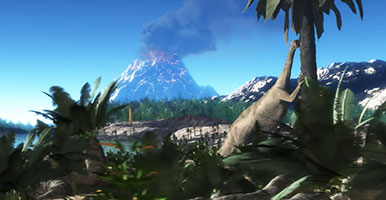- Type of dinosaur:
- large theropod
- Length:
- 8.0m
- Diet:
- carnivorous
- When it lived:
- Late Cretaceous, 69-71 million years ago
- Found in:
- Argentina
Carnotaurus was a meat-eating dinosaur with two horns on the top of its head and very small arms.
It had an unusually short snout and its head was very narrow when viewed from the front.
Scientists have found lots of skin impressions for this dinosaur, so we know that it had scales over much of its body. It's unlikely that Carnotaurus or its relatives had feathers - no evidence of them has ever been found.
We also don't have a complete skeleton. So far, nobody has ever found the tail or lower legs of Carnotaurus. This means we must use some guesswork based on the remains of this dinosaur's close relatives to do a full-body reconstruction.
Why did Carnotaurus have horns?
Nobody is quite sure what Carnotaurus' horns were for. Some experts think the dinosaur might have used them to fight rivals or attack prey.
Another idea is that the horns might have helped to attract a mate or identify other Carnotaurus.
Why were Carnotaurus' arms so small?
Experts believe that Carnotaurus' ancestors would have had longer arms. Over time the arms got smaller and less useful.
Carnotaurus probably didn't use its arms for much. They were a leftover trait from the dinosaur's earlier ancestors.
Scientists call this a vestigial feature. It comes from the word 'vestige', meaning 'a small trace of something that existed a long time ago'.
Many animals have vestigial features, including humans. For example, you still have a tailbone in your skeleton, even though you don't have a tail!
Could Carnotaurus camouflage itself?
In his novel The Lost World - the sequel to Jurassic Park - Michael Crichton described Carnotaurus as able to disguise itself with changing skin colours, like a chameleon.
We don't have evidence that any dinosaur ever had this ability. If they did, we wouldn't be able to tell from fossil remains.
It's always possible that any given dinosaur might have had an unusual or surprising feature that isn't shown in fossils. Fiction is a great place to explore interesting ideas.
Were any other dinosaurs like Carnotaurus?
Although Carnotaurus looked unusual with its tiny arms and short snout, it wasn't the only dinosaur like this.
Carnotaurus was part of the abelisaur group. These closely related dinosaurs shared similar characteristics. But Carnotaurus is the only one known to have two horns on its head.
Other abelisaurs include Abelisaurus itself, Majungasaurus and the Indian predator Rajasaurus.
Was Carnotaurus related to Tyrannosaurus?
Carnotaurus and Tyrannosaurus weren't very closely related.
The two dinosaurs do share some similarities - both are meat-eating dinosaurs that walked on two legs. But they are also quite different.
Tyrannosaurs had more powerful jaws and teeth than abelisaurs, as well as longer arms with two-fingered hands. Abelisaurs had four fingers on each hand. Tyrannosaurs could also grow much larger.
Carnotaurus and Tyrannosaurus belong to two different dinosaur groups - ceratosaurs and coelurosaurs. These groups might have been evolving apart for more than 100 million years, since the Late Triassic Period.
Where did Carnotaurus live?
Carnotaurus fossils have only been found in Argentina. They occur in Late Cretaceous rocks that may have formed from the deposits of estuaries or tidal flats.
We know Carnotaurus shared its environment with other dinosaurs. Researchers have found partial remains of as-yet unnamed ankylosaurs and hadrosaurs in the same area, but we don't know exactly what these dinosaurs were like.
What did Carnotaurus eat?
Although it was clearly a meat-eater, nobody knows for sure what types of animals Carnotaurus hunted.
Many experts think it probably preyed on large sauropod dinosaurs. Teeth belonging to related abelisaurs have been found with sauropod remains, so it seems likely.
Carnotaurus had a more flexible lower jaw than most other carnivorous dinosaurs. It may have been able to open its jaw wide, like a snake, to swallow big chunks of meat.
Originally, researchers thought that the flexible jaw meant Carnotaurus didn't have a very strong bite. But more recent studies contradict this. Some experts think Carnotaurus may even have had a stronger bite force than an American alligator, the most powerful biting creature alive today.
What is the correct plural of Carnotaurus?
When you're talking about more than one dinosaur of a particular kind, you don't need to put an 's' on the end.
You can think of it the same way as you would say 'two sheep'.
This applies to all dinosaur names - so you can say 'two Carnotaurus' or 'five Velociraptor'.
Taxonomic details
- Taxonomy:
- Dinosauria, Saurischia, Theropoda, Neotheropoda, Ceratosauria, Abelisauridae
- Named by:
- Bonaparte (1985)
- Type species:
- sastrei






